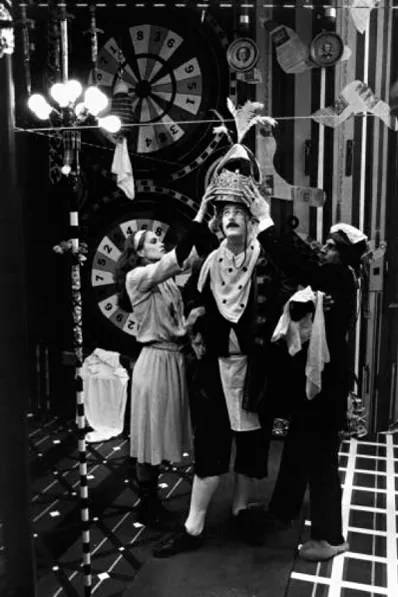![]()
King Cowboy Rufus Rules the Universe!
![]()
PRODUCTION HISTORY
King Cowboy Rufus Rules the Universe! Produced by the Ontological-Hysteric Theater at the Ontological at St. Mark’s Theater, New York City. January–April 2004. Written, directed and designed by Richard Foreman.
RUFUS | Jay Smith |
BARON DEVOTO | T. Ryder Smith |
SUZIE | Juliana Francis Kelly |
CREW | Michelle Diaz, Tommy Smith, Joel Israel, Betsy Ware, Suzi Takahashi, Shauna Kelly, Brenda Hattingh |
![]()
![]()
A large room in a restaurant, but with very few tables. Several tall Renaissance-style portraits in heavy gilded frames hang on the walls. A noose of worn rope hangs down from the ceiling in front of each painting. The walls themselves are covered in striped wallpaper and decorated with checkerboards, displayed at an oblique angle and lined up one next to the other to produce several vertical columns of diamond-shaped checkerboards. There is a large bank of fluorescent lights hanging from one part of the ceiling. The floor is painted with white crisscrossing lines and the whole room vibrates with additional bric-a-brac attached to the walls—including tiny flags from different nations and strange, thin, amoeba-like cutout strips of newspaper glued to the walls—as well as the names of American presidents painted on the top edges of the walls in small gold letters.
On one side of the stage, large letters in script spell out LA MAISON ROUGE.
At the front of the stage are thin poles with branching, multiple-bulb light fixtures on top. A few more of these light poles are distributed throughout the first rows of the audience. In addition, a narrow red carpet runs from the back of the stage out into the first few rows of the audience, where arches form a kind of metal cage.
Often, when King Cowboy Rufus advances out into the audience inside this cage, the light poles in the audience become brightly illuminated—but they also turn on at less appropriate moments.
There is music of different styles and periods throughout the play (even more than is indicated in the text), and a high “ping” and a four-note chime tune/punctuate the dialogue at appropriate moments—either mocking what has been said or stopping the action for a moment’s reflection.
But now, as the play begins, accordion polka music fills the room.
The Baron Herman DeVoto stands alone on the stage, staring at the audience. He wears a threadbare suit. His chest is covered by a small wooden panel suspended from his neck, upon which are displayed old military medals. He wears an unconvincing black wig, and resting on top of that is a pearl-decorated napkin, making him resemble certain official photographs of Queen Victoria. On his feet he wears oversized, furry pink slippers.
He stands frozen, and then, suddenly, he slaps himself in the face. There is a loud crash and the music lowers. Throughout the play he speaks in a quiet growl, like a nineteenth-century American ruffian.
BARON: You can’t know the answer to this riddle.
(He waits, then slaps himself again. There is a crash as the music stops.)
Come to think of it—
(He looks to the side of the stage and watches as Suzie appears and walks slowly to the center of the room. She is a beautiful English coquette, wearing a stylish 1930s cream-colored dress. She speaks with an English accent.)
SUZIE (Speaking quietly and deliberately): My name is Suzie. Remember that name.
BARON (Staggering upstage): I don’t even know how to properly formulate this riddle.
HELP ME!
HELP ME!
(Music again rises—someone singing wistfully: “Never again, oh never again.” A cigarette girl in a sexy black waitress costume enters holding a cigarette tray, from which the Baron takes a cigarette. Suzie puts on a blindfold.)
SUZIE: I’m ready.
(The Baron puts the cigarette into Suzie’s mouth as the cigarette girl points to a nearby target. The Baron takes a knife and prepares to throw it to displace the cigarette that dangl...

